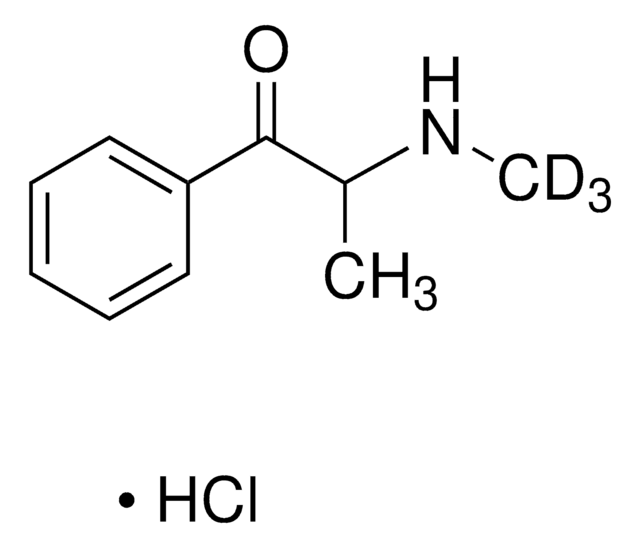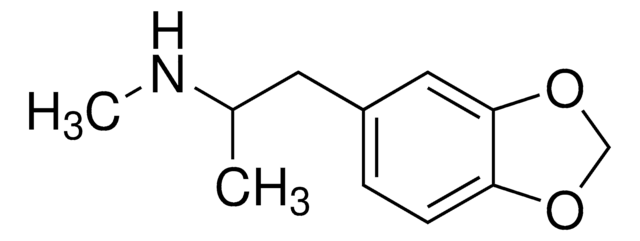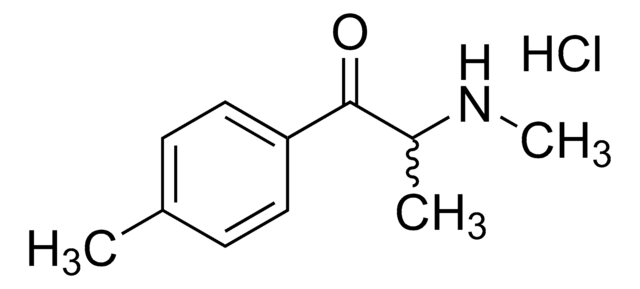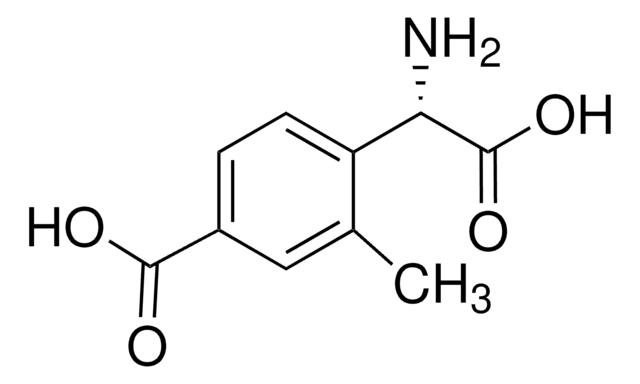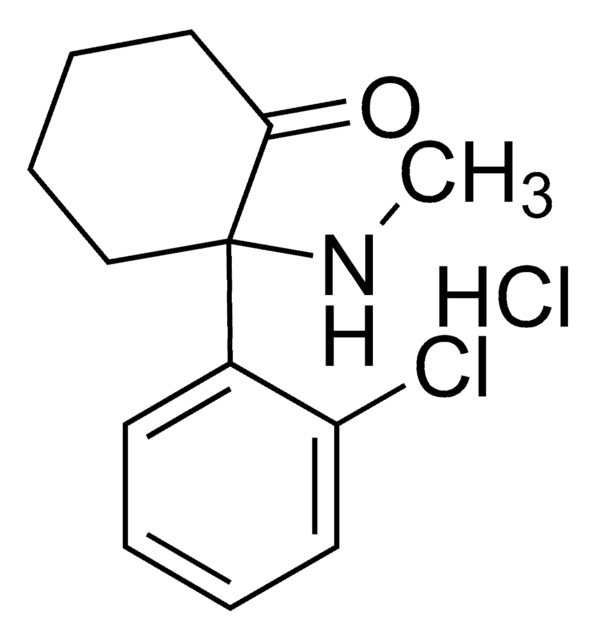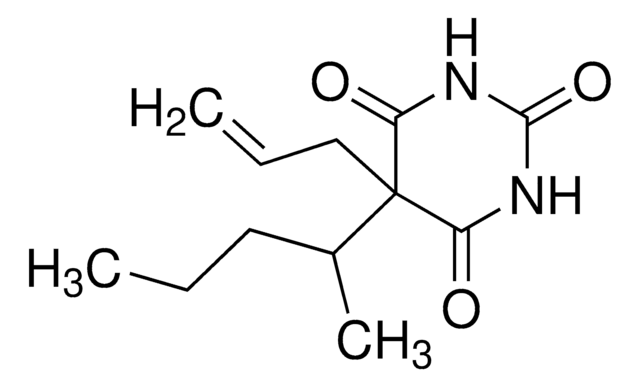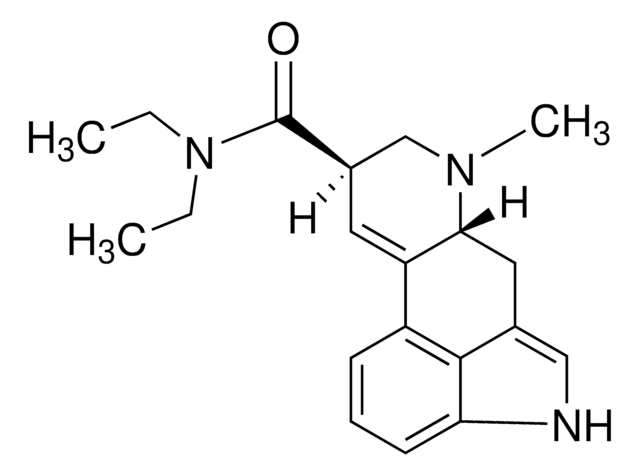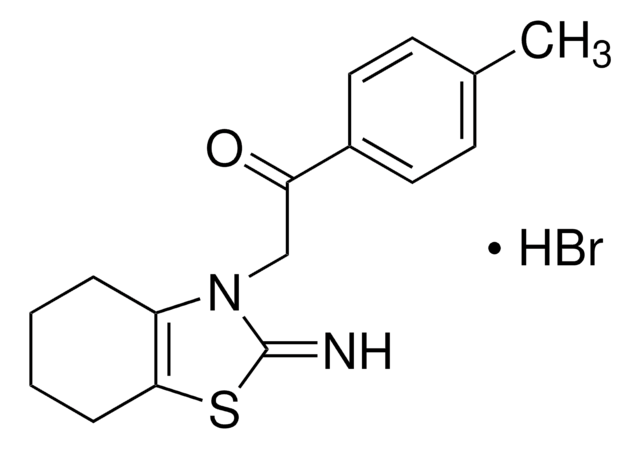Wszystkie zdjęcia(1)
Kluczowe dokumenty
M5435
6-Methyl-2-(phenylethynyl)pyridine hydrochloride
≥98% (HPLC)
Synonim(y):
MPEP hydrochloride
Zaloguj sięWyświetlanie cen organizacyjnych i kontraktowych
About This Item
Wzór empiryczny (zapis Hilla):
C14H11N · HCl
Numer CAS:
Masa cząsteczkowa:
229.70
Numer MDL:
Kod UNSPSC:
12352200
Identyfikator substancji w PubChem:
NACRES:
NA.77
Polecane produkty
Próba
≥98% (HPLC)
Formularz
powder
kolor
off-white to light tan
rozpuszczalność
DMSO: 10 mg/mL, clear
temp. przechowywania
room temp
ciąg SMILES
Cl.Cc1cccc(n1)C#Cc2ccccc2
InChI
1S/C14H11N.ClH/c1-12-6-5-9-14(15-12)11-10-13-7-3-2-4-8-13;/h2-9H,1H3;1H
Klucz InChI
PKDHDJBNEKXCBI-UHFFFAOYSA-N
informacje o genach
human ... GRIN2B(2904) , GRM5(2915)
rat ... Grm5(24418)
Opis ogólny
GRIN2B (glutamate ionotropic receptor NMDA type subunit 2B) codes for N-methyl d-aspartate receptor subtype 2B (GluN2B). It belongs to the N-methyl-D-aspartate receptor (NMDAR) gene family. It is located on chromosome 12p13.1.
Zastosowanie
6-Methyl-2-(phenylethynyl)pyridine hydrochloride has been used to investigate whether 3, 4 (±) methylenedioxymethamphetamine (MDMA) could influence self-renewal via the mGlu5 receptor in mouse embryonic stem cells (mESCs).
Działania biochem./fizjol.
GRIN2B (glutamate ionotropic receptor NMDA type subunit 2B) plays an important role in the growth of neurons and is highly essential for learning and memory. GRIN2B mutation is associated with neuropsychiatric and developmental disorders like schizophrenia, Parkinson′s disease and bipolar disorder. MPEP (2-methyl-6-(phenylethynyl)pyridine hydrochloride) is used to treat Alzheimer′s disease (AD).
Highly selective, non-competitive mGluR5 metabotropic glutamate receptor antagonist.
Cechy i korzyści
This compound is a featured product for Neuroscience research. Click here to discover more featured Neuroscience products. Learn more about bioactive small molecules for other areas of research at sigma.com/discover-bsm.
This compound is featured on the Glutamate Receptors (G Protein Family) page of the Handbook of Receptor Classification and Signal Transduction. To browse other handbook pages, click here.
Ta strona może zawierać tekst przetłumaczony maszynowo.
Kod klasy składowania
11 - Combustible Solids
Klasa zagrożenia wodnego (WGK)
WGK 3
Temperatura zapłonu (°F)
Not applicable
Temperatura zapłonu (°C)
Not applicable
Środki ochrony indywidualnej
Eyeshields, Gloves, type N95 (US)
Wybierz jedną z najnowszych wersji:
Masz już ten produkt?
Dokumenty związane z niedawno zakupionymi produktami zostały zamieszczone w Bibliotece dokumentów.
Klienci oglądali również te produkty
José Luis Albasanz et al.
ACS chemical neuroscience, 7(12), 1690-1697 (2016-09-17)
Due to phylogenetic proximity to the human, zebrafish has been recognized as a reliable model to study Alzheimer's disease (AD) and other central nervous system disorders. Furthermore, metabotropic glutamate receptors have been previously reported to be impaired in brain from
Human GRIN2B variants in neurodevelopmental disorders
Hu C, et al.
Journal of Pharmacological Sciences, 132(2), 115-121 (2016)
Li Rebekah Feng et al.
Translational psychiatry, 8(1), 110-110 (2018-06-01)
Cancer-related fatigue (CRF) is a common burden in cancer patients and little is known about its underlying mechanism. The primary aim of this study was to identify gene signatures predictive of post-radiotherapy fatigue in prostate cancer patients. We employed Fisher
Geehoon Chung et al.
Scientific reports, 7(1), 9743-9743 (2017-08-31)
Patients with chronic pain easily accompany the negative mood symptoms such as depression and anxiety, and these disturbances in turn affect the aversive perception of pain. However, the underlying mechanisms are largely unknown. We hypothesized that the alteration of metabotropic
Mélanie Cavalier et al.
Neurochemical research, 44(3), 609-616 (2018-01-22)
Maternal immune challenge has proved to induce moderate to severe behavioral disabilities in the offspring. Cognitive/behavioral deficits are supported by changes in synaptic plasticity in different brain areas. We have reported previously that prenatal exposure to bacterial LPS could induce
Nasz zespół naukowców ma doświadczenie we wszystkich obszarach badań, w tym w naukach przyrodniczych, materiałoznawstwie, syntezie chemicznej, chromatografii, analityce i wielu innych dziedzinach.
Skontaktuj się z zespołem ds. pomocy technicznej